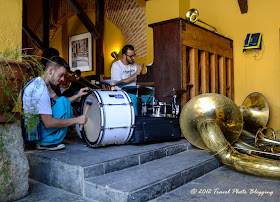Soča river valley in Slovenia is one of top European destinations for adrenaline addicts, water-sports enthusiasts and nature lovers.
The place literally looks like out of a fairytale and obviously I am not the only one who noticed it. A part of the movie The Chronicles of Narnia: Prince Caspian was filmed in the town of Bovec. They filmed the climax of the battle at Beruna's Bridge there.
This place has been a popular destination for water sports like rafting and kayaking for decades. There are also other activities worth looking at when visiting the area. Canyoning and paragliding are definitely two of them and recently also zip-line has joined this already very interesting array of choices.
I have already tried some of those things before and really liked them. This time I decided to try this new thing simply called - Zipline Slovenia.
Zip-lining (also known as a flying fox, aerial ropeslide or Tyrolean slide) consists of a pulley suspended on a cable spanning between two high points. Simply put - gravity helps you travel from the top to the bottom of the inclined cable by attaching to (and hanging from) the freely moving pulley.
This particular zip-line adventure starts with a scenic drive up the mountainside in an ex-military 4x4 car (TAM-110). Even views from the back of the car are spectacular and as such just the right introduction for the things to come.
First you get all the necessary equipment and after a quick training course the real thing begins...
The 2.4 kilometers long zip-line is divided in four sections - approximately 500 meters each. After every slide there is a short - few minute walk to the start of the next line. The path is quite steep in some parts so do not forget to bring comfortable trekking shoes.
The estimated top speed of the fastest line is over 60km/h and the cables are set 130-200 meters above the ground, each providing stunning views of the Soča river valley.
Personally I liked the one going through tree canopies best. Tree branches flying past gave an impression of even greater speed.
Throughout the whole experience the two instructors kept a close eye on individual participants giving us tips and precise instructions regarding safety and appropriate aerodynamic positions on each of the rides.
Everything from arranging this 3 hour adventure to the actual rides on the lines was done very professionally and I can only recommend it. Despite the natural environment this "adventure park" is set in, the whole thing felt surprisingly safe and controlled all the way through.
If you are having second thoughts about doing this because of a mild fear of heights - trust me, you do not need to worry about a thing. I actually think you will enjoy this zip-line the most if you are not completely comfortable with heights and exercises involving yourself hanging from a wire while flying super fast from one hill to another.
A scream echoing from the mountains now and then will only add to the whole experience.
Since this is the longest and the most spectacular zip-line in this part of Europe, it can get pretty crowded. Booking ahead of time is highly recommended. Visit Zipline Slovenia on their webpage for additional information.
If you find yourself strolling through the center of Bovec, you can also visit Aktivni Planet tourist agency. They will provide all the information you may need. They speak perfect English.































